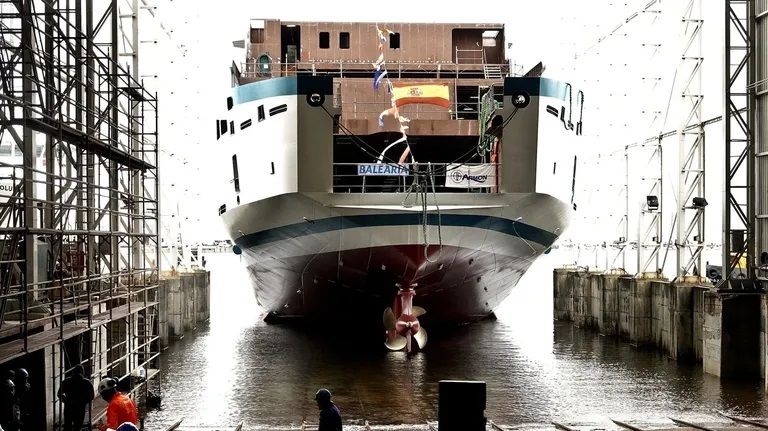Vigo’s shipbuilding transformation: less polluting, faster and luxurious ships

Renaissance yacht, an oceanographic yacht commissioned by the USA, the first electric ferry in Spain and drug trafficking patrol boats in Gibraltar mark the milestones of the sector in the year that ends.
It is time for transformation and embracing new markets. Vigo´s shipbuilding industry has recently lost two reference shipyards, Barreras and Vulcano, which permanently provided workload and opportunities to an entire sector around the area and which nearly 9,000 people worked for, most of them in subsidiary companies. It was time to get back together. Freire Shipyard and Armón have become the big players of this decade and alongside them there are also smaller factories that are anchoring Vigo to one of its main engines, such as shipbuilding. The order book from medium and small shipyards in 2023 has allowed us to mark authentic milestones that reflect the way in which the naval industry is making its way to continue being a benchmark for companies and institutions around the world.
It was time to get recovered. Freire Shipyard and Armón have become the big players of this decade and next to them there are also smaller factories that are anchoring Vigo to one of their main powers, such as shipbuilding. The order book from medium and small shipyards in 2023 has allowed us to mark authentic milestones reflecting the way shipbuilding industry is making its way to continue being a benchmark for companies and institutions around the world.
This year, the luxury shipbuilding industry turned its gaze over and focused it on the Vigo’s Bay thanks to Renaissance, the largest ship of its category ever built in Spanish slipways, the most expensive charter yacht in the world, according to the Burgess agency. Freire Shipyard dedicated two years to launching it, in addition to a team of over 600 members. The yacht said goodbye to Galicia in autumn, stunning with its 112 meters-long and drawing the wake of the most iconic work delivered in the estuary since the pandemic.
At the start of the year, the same shipyard delivered Falkor (Too) to the oceanographic foundation Schmidt Ocean Institute, in California. It was the first time the United States entrusted a foreign shipyard with the transformation (and construction) of a marine research vessel. At the Vigo shipyard they converted the Polar Queen, an offshore vessel that served the oil industry, into a vessel dedicated to the discovery of the seabed and its environmental care. The new times paradigm.
Now, the shipyard is completing David Packard, also designed for oceanographic science, and named in honour of HP founder, who after founding the computer company became involved with the oceans and advocated sending instruments to the bottom of the sea and not people. Its owner is the Monterey Bay Aquarium Research Institute (MBARI), in the United States.
Armón shipyard milestone reflects the way in which Vigo’s shipbuilding industry faces the great decarbonization challenge. Last May, they delivered Cap de Babaria, the first electric ferry in Spain, to Balearia. It is designed to be silent and reduce its acoustic impact in a natural protection area such as the Balearic Islands, where it operates, between Ibiza and Formentera. The boat does not generate polluting emissions in port (in entrances, exits, or stays at the dock) because it is equipped with an electric battery system that is recharged during the voyage and allows greenhouse gases to be reduced by up to 80%. On the steps of the same shipyard, they are now advancing on the jewel of Spanish oceanography, Odón de Buen. She will represent a qualitative leap for the marine research arm of the CSIC because she will sail between 200 and 300 nautical miles.
For the industry of this city, it has also been a milestone the first ship built in the new Barreras, directed by Armón and officially called Ría de Vigo. Last August, Erin Bruce II, a fishing vessel designed to capture scallops, was completed by the Argentine shipowner Wanchese. The relationship was even more iconic because it was a company of the Cooke group, the Canadian conglomerate was interested in purchasing Nueva Pescanova, but ultimately backed out.
On the other side of the estuary, Aister forged another notable exercise. The shipyard from Moaña, specialized in aluminium construction, delivered last February an ultra-fast police intervention patrol boat, the Río Flumen. The boat, capable of reaching 60 knots, is designed to combat an endemic evil in the Strait of Gibraltar such as drug trafficking. In summer, they incorporated a twin boat in Huelva. In this area, the Rodman shipyard also activated this year the construction of several high-speed patrol boats for Customs to pursue this scourge.
Another feat is achieved by the small shipyard Seadrone. Its Sead 23 unmanned model participated last April in a Navy deployment in the Mediterranean Sea. They managed to integrate this vessel into the world of 5G technology, another milestone in the field of communications on the high seas.
Source: La Voz de Galicia

